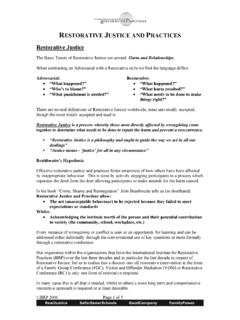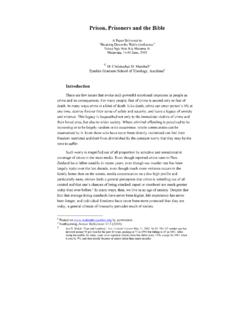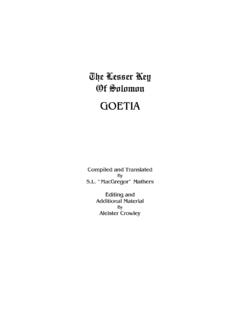Transcription of Exploring the History - IIRP Graduate School
1 1 Exploring the History of the restorative justice MovementOne thing that stands out to me about the academic literature on restorative justice is thatthe History of this phenomenon is given very little consideration. Usually, the History ofrestorative justice is presented as a single obligatory paragraph at the beginning of a bookor article, and appears as a mere preface to the real content of the remainder of the give you an example, Russ Immarigeon (1996) opens his book chapter on prison-based Victim-Offender Reconciliation programs by claiming:Just over 20 years ago, the first victim-offenderreconciliation meeting was held in Kitchener, Ontario,CAN (Peachey, 1989). Several years later, a victim-offender meeting was held in Elkhart, IN (Umbreit,1985).
2 Subsequently, the concept of victim-offenderreconciliation has gained widespread and worldwideacceptance (p. 463). Interestingly, these histories conflict with one another, with the origins of restorativejustice being variously ascribed to the Victims Rights Movement, indigenous justicepractices, a range of religious persuasions, and so authors do consider the History of restorative justice in greater detail, a number ofproblems arise. Where should this History begin? Should one start at the point where theterm restorative justice came into popular usage, or go further back in time, linkingmodern restorative practices with historical precursors such as restitution or indigenousjustice? Do such histories amount to harmless explorations of the past, or do they have amore strategic purpose?
3 2 The argument I will make in this paper is as follows: the body of literature on restorativejustice, and particularly that literature which addresses the History of this phenomenonuses History as a strategy to render restorative justice a legitimate and politically palatablecriminal justice option in the present. These histories act however inadvertently tomake restorative justice appear as a natural and unproblematic, and at times miraculous and panacean paradigm of criminal the first section of this paper, I will use Elmar Weitekamp s (1999) ambitiously titledessay The History of restorative justice as a case in point. Weitekamp s History draws ontwo main sources in order to legitimise the ascendancy of restorative justice : firstly, helooks at the legal anthropological literature, and secondly, at what we might call thehistorical criminological literature.
4 Let s consider firstly his use of the (1999) draws on a range of well-known works of legal anthropology in orderto support his bold claim that restorative justice has existed since humans began formingcommunities (p. 81). He says, It is kind of ironic that we have .to go back to methodsand forms of conflict resolution that were practiced some millennia ago by our ancestorswho seemed to be much more successful than we are today (p. 93).3In support of this claim, Weitekamp cites evidence from a diverse range of sources fromthe practices of ancient indigenous Australian and Eskimo communities, to the Code ofHammurabi, the Laws of Ethelbert of Kent and even Homer s , of course, is not alone in making these claims, and most of you will be awareof the monotonous regularity with which this assertion is made.
5 It is perhaps epitomisedin Braithwaite s (1999) widely quoted remark that restorative justice has been thedominant model of criminal justice throughout most of human History for all the world speoples (p. 2).Although such claims have been dismissed by scholars such as Anthony Bottoms (2003,p. 88), who claims that they are easily refuted by any serious look at the work of legalanthropologists, my argument here is more far-reaching than this. I do not intend tomerely refute claims about the universal practice of restorative justice in ancient andindigenous communities, but to demonstrate that by making these claims, authors such asWeitekamp are using History to legitimise restorative justice in similar argument has recently been made by Douglas Sylvester (2003) in an articletitled Myth in restorative justice History .
6 Sylvester (2003) returns to the sameanthropological sources on which Weitekamp (1999) draws in order to assess the validityof his claims; his conclusions however, are markedly different. In a nutshell, Sylvester sexamination of these same texts reveals that in addition to the so-called restorative 4practices that they suggest were utilised in ancient societies, a range of highly retributivepractices were widely used in these communities as s consider Weitekamp s use of E. Adamson Hoebel s famous anthropological workThe Law of Primitive Man to provide just one example. Drawing on Hoebel s work,Weitekamp (1999) claims that blood revenge was rarely used in Eskimo communities,even in homicide matters. In support of his claim, he quotes the following from Hoebel swork:Murder is followed quite regularly by the murderertaking over the widow and children of the victim.
7 Inmany instances the desire to acquire the woman is thecause of the murder, but where this is not the motive,a social principle requiring provisions for thebereaved family places the responsibility directlyupon the murderer (p. 76).Weitekamp (1999) goes on to comment on the ingenuity of this system of dealing withconflict, by claiming that [Albert] Eglash who coined the term creative restitution would have been delighted by the creativity of these Eskimo communities (p. 76).Contrary to Weitekamp s argument however, I would in fact suggest that nobody in theirright mind, let alone Albert Eglash, would find the prospect of a man murdering another5man, and then supposedly repairing this damage by shacking up with his wife and kids delightful in any Sylvester (2003, p.)
8 12) however, there are more profound problems withWeitekamp s use of Hoebel s work than this. After examining the same text thatWeitekamp uses in order to demonstrate the absence of retribution in ancient societies,Sylvester (2003) discovered that in The Law of Primitive Man, Hoebel describesnumerous instances of Eskimo clans carrying out revenge killings for a variety ofoffences. Although Hoebel admits that such killings were made less frequent by thepractice of restitution, his work hardly supports Weitekamp s claim that revenge killingswere used only rarely (Sylvester, 2003, p. 12).Sylvester (2003) thus concludes that the argument put forward by Weitekamp and otherrestorative justice scholars is either grossly overstated or flatly contradicted by Hoebel sconclusions (p.
9 12). Furthermore, after reviewing all of the other examples used byWeitekamp (1999) and others in the same manner, Sylvester (2003) concludes that thereis little doubt that restorative justice scholars have only scratched the surface of theanthropological literature and have been highly selective in the examples expressed ( ).There is a great deal more that could be said about the claim that restorative justice hasbeen the dominant method of dealing with conflict for most of human History . Suffice itto say at this point however, that the work of Bottoms (2003), Sylvester (2003) and others6demonstrates that although restorative processes almost certainly existed in pre-moderncommunities, they existed alongside a diverse range of other practices, includingretribution.
10 In Braithwaite s (1996) own words, I have yet to discover a culture whichdoes not have some deep-seated restorative traditions. Nor is there a culture withoutretributive traditions (p. 327). My point here is that it therefore cannot be the indigenousness or ancientness of restorative processes alone that has allowed them tobe accepted into criminal justice systems today. If this was the case, and currentgovernments were to implement justice measures based solely on their having beenpracticed in indigenous and pre-modern societies, a whole range of practices fromrestorative justice to spearing, banishment and death would currently be in s move on to Weitekamp s second and I think, far more interesting - method ofdrawing on the past in order to legitimate the current use of restorative justice .











